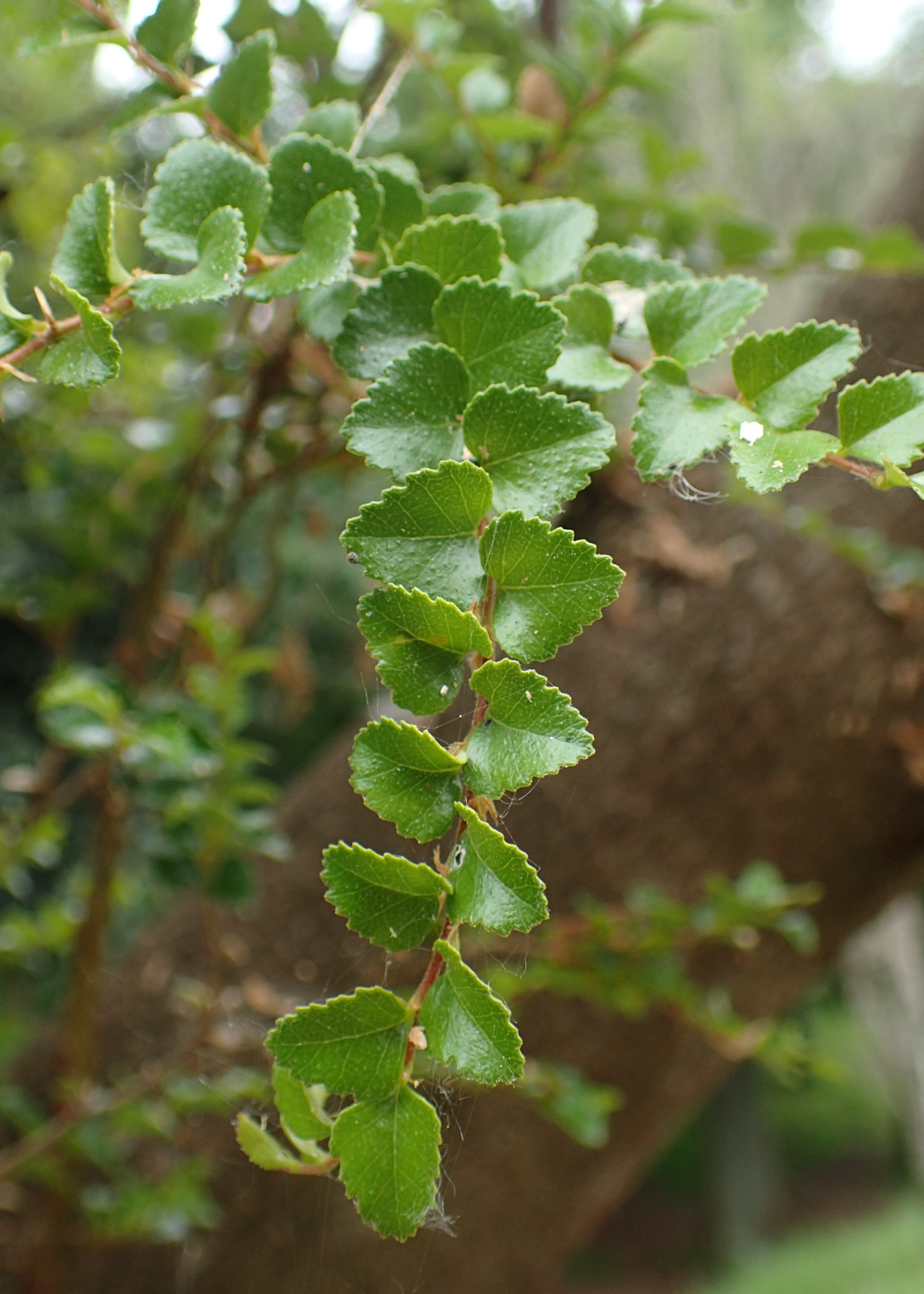|
Myrtle Beech
''Nothofagus cunninghamii,'' commonly known as myrtle beech or Tasmanian myrtle, is the dominant species of cool temperate rainforests in Tasmania and Southern Victoria. It has low fire resistance and grows best in partial shade conditions. It has rough bark covered in mosses and epiphytic growth. Its leaves are triangular-shaped, small, and dark green with differentiated margins. It has white unisexual flowers. Description & Habit ''N. cunninghamii'' range from trees of up to 50 meters in protected rainforest valleys to low-growing alpine shrubs less than 1 m tall in exposed conditions. Maximum height is about 55 m. The leaves are simple and alternate, growing 0.5–1.5 cm long, and in Victoria up to 2 cm (0.8 in) long. The leaves are dark green, with new growth brilliant red, pink or orange in spring. They are triangular with irregular minute teeth with craspedodromous veins with all secondary veins terminate at leaf margins and spread from a central primary ... [...More Info...] [...Related Items...] OR: [Wikipedia] [Google] [Baidu] |
Joseph Dalton Hooker
Sir Joseph Dalton Hooker (30 June 1817 – 10 December 1911) was a British botanist and explorer in the 19th century. He was a founder of geographical botany and Charles Darwin's closest friend. For twenty years he served as director of the Royal Botanical Gardens, Kew, succeeding his father, William Jackson Hooker, and was awarded the highest honours of British science. Biography Early years Hooker was born in Halesworth, Suffolk, England. He was the second son of the famous botanist Sir William Jackson Hooker, Regius Professor of Botany, and Maria Sarah Turner, eldest daughter of the banker Dawson Turner and sister-in-law of Francis Palgrave. From age seven, Hooker attended his father's lectures at Glasgow University, taking an early interest in plant distribution and the voyages of explorers like Captain James Cook. He was educated at the Glasgow High School and went on to study medicine at Glasgow University, graduating M.D. in 1839. This degree qualified ... [...More Info...] [...Related Items...] OR: [Wikipedia] [Google] [Baidu] |
Atherosperma
''Atherosperma moschatum'', the southern sassafras or blackheart sassafras, is an evergreen tree native to the cool temperate rainforests of Tasmania, Victoria, and New South Wales in Australia. It is common in the rainforests of Tasmania and Victoria, but more scattered and rare in the higher altitudes of eastern New South Wales. The northernmost area is at Mount Grundy, west of Port Macquarie. Taxonomy The southern sassafras was first described by French naturalist Jacques Labillardière in 1806, and was the only member of the genus ''Atherosperma''. A subspecies, ''A. m.'' subsp.'' integrifolium'', has been considered a separate species. Its generic name is derived from the Ancient Greek ''ather'' "awn", and ''sperma'' "seed", from the hairs on the fruit, and the specific epithet ''moschatum'' is the Latin adjective meaning "musk-scented", from the smell of the bark. It is a member of the small family Atherospermataceae along with several other Australian rainforest trees ... [...More Info...] [...Related Items...] OR: [Wikipedia] [Google] [Baidu] |
Joiner
A joiner is an artisan and tradesperson who builds things by Woodworking joints, joining pieces of wood, particularly lighter and more ornamental work than that done by a Carpentry, carpenter, including furniture and the "fittings" of a house, ship, etc. Joiners may work in a workshop, because the formation of various joints is made easier by the use of non-portable, powered machinery, or on job site. A joiner usually produces items such as interior and exterior doors, windows, stairs, tables, bookshelves, cabinets, furniture, etc. In shipbuilding a ''marine joiner'' may work with materials other than wood such as linoleum, fibreglass, hardware, and gaskets. The terms ''joinery'' and ''joiner'' are in common use in the UK, Australia, and New Zealand. The term is not in common use in North America, although the main trade union for American carpenters is called the United Brotherhood of Carpenters and Joiners of America. In the UK, an apprentice of wood occupations could choose ... [...More Info...] [...Related Items...] OR: [Wikipedia] [Google] [Baidu] |
Cabinetry
A cabinet is a case or cupboard with shelves and/or drawers for storing or displaying items. Some cabinets are stand alone while others are built in to a wall or are attached to it like a Bathroom cabinet, medicine cabinet. Cabinets are typically made of wood (solid or with Wood veneer, veneers or artificial surfaces), coated steel (common for medicine cabinets), or synthetic materials. Commerce, Commercial grade cabinets usually have a melamine-particleboard substrate and are covered in a high pressure decorative laminate, commonly referred to as Wilsonart or Formica. Cabinets sometimes have one or more doors on the front, which are mounted with Door furniture, door hardware, and occasionally a Lock (security device), lock. Cabinets may have one or more doors, Drawer (furniture), drawers, and/or Shelf (storage), shelves. Short cabinets often have a finished surface on top that can be used for display, or as a working surface, such as the countertops found in kitchens. A cabinet ... [...More Info...] [...Related Items...] OR: [Wikipedia] [Google] [Baidu] |
Frass
Frass refers loosely to the more or less solid excreta of insects, and to certain other related matter. Definition and etymology ''Frass'' is an informal term and accordingly it is variously used and variously defined. It is derived from the German word ''Fraß'', which means the food takeup of an animal.M. Clark and O. Thyen. The Oxford-Duden German Dictionary. Publisher: Oxford University Press 1999. The English usage applies to excreted residues of anything that insects had eaten, and similarly, to other chewed or mined refuse that insects leave behind. It does not generally refer to fluids such as honeydew, but the point does not generally arise, and is largely ignored in this article. Such usage in English originated in the mid-nineteenth century at the latest. Modern technical English sources differ on the precise definition, though there is little actual direct contradiction on the practical realities. One glossary from the early twentieth century speaks of "...excreme ... [...More Info...] [...Related Items...] OR: [Wikipedia] [Google] [Baidu] |
Ambrosia Beetle
Ambrosia beetles are beetles of the weevil subfamilies Scolytinae and Platypodinae (Coleoptera, Curculionidae), which live in nutritional symbiosis with ambrosia fungi. The beetles excavate tunnels in dead, stressed, and healthy trees in which they cultivate fungal gardens, their sole source of nutrition. After landing on a suitable tree, an ambrosia beetle excavates a tunnel in which it releases spores of its fungal symbiont. The fungus penetrates the plant's xylem tissue, extracts nutrients from it, and concentrates the nutrients on and near the surface of the beetle gallery. Ambrosia fungi are typically poor wood degraders, and instead utilize less demanding nutrients. The majority of ambrosia beetles colonize xylem (sapwood and/or heartwood) of recently dead trees, but some attack stressed trees that are still alive, and a few species attack healthy trees.Hulcr, J. and Stelinski, L.L., 2017. The ambrosia symbiosis: From evolutionary ecology to practical management. Annual Revi ... [...More Info...] [...Related Items...] OR: [Wikipedia] [Google] [Baidu] |
Tertiary
Tertiary ( ) is a widely used but obsolete term for the geologic period from 66 million to 2.6 million years ago. The period began with the demise of the non- avian dinosaurs in the Cretaceous–Paleogene extinction event, at the start of the Cenozoic Era, and extended to the beginning of the Quaternary glaciation at the end of the Pliocene Epoch. The time span covered by the Tertiary has no exact equivalent in the current geologic time system, but it is essentially the merged Paleogene and Neogene periods, which are informally called the Early Tertiary and the Late Tertiary, respectively. The Tertiary established the Antarctic as an icy island continent. Historical use of the term The term Tertiary was first used by Giovanni Arduino during the mid-18th century. He classified geologic time into primitive (or primary), secondary, and tertiary periods based on observations of geology in Northern Italy. Later a fourth period, the Quaternary, was applied. In the early ... [...More Info...] [...Related Items...] OR: [Wikipedia] [Google] [Baidu] |
Gondwana
Gondwana () was a large landmass, often referred to as a supercontinent, that formed during the late Neoproterozoic (about 550 million years ago) and began to break up during the Jurassic period (about 180 million years ago). The final stages of break-up, involving the separation of Antarctica from South America (forming the Drake Passage) and Australia, occurred during the Paleogene. Gondwana was not considered a supercontinent by the earliest definition, since the landmasses of Baltica, Laurentia, and Siberia were separated from it. To differentiate it from the Indian region of the same name (see ), it is also commonly called Gondwanaland. Gondwana was formed by the accretion of several cratons. Eventually, Gondwana became the largest piece of continental crust of the Palaeozoic Era, covering an area of about , about one-fifth of the Earth's surface. During the Carboniferous Period, it merged with Laurasia to form a larger supercontinent called Pangaea. Gondwana ... [...More Info...] [...Related Items...] OR: [Wikipedia] [Google] [Baidu] |
Bewitched Tasmanian Forest
''Bewitched'' is an American fantasy sitcom television series that originally aired for eight seasons on ABC from September 17, 1964, to March 25, 1972. It is about a witch who marries an ordinary mortal man and vows to lead the life of a typical suburban housewife. The show was popular, finishing as the second-rated show in America during its debut season, staying in the top ten for its first three seasons, and ranking in eleventh place for both seasons four and five. The show continues to be seen throughout the world in syndication and on recorded media. ''Bewitched'' was created by Sol Saks under executive producer Harry Ackerman and starred: Elizabeth Montgomery as Samantha Stephens; Dick York (1964–1969) as Darrin Stephens, her husband (Dick Sargent replaced an ailing York for the final three seasons, 1969–1972); Agnes Moorehead as Endora, Samantha's mother; David White as Larry Tate, Darrin's boss; Irene Vernon (1964–1966) and later Kasey Rogers (1966–1972) as ... [...More Info...] [...Related Items...] OR: [Wikipedia] [Google] [Baidu] |
Epiphyte
An epiphyte is an organism that grows on the surface of a plant and derives its moisture and nutrients from the air, rain, water (in marine environments) or from debris accumulating around it. The plants on which epiphytes grow are called phorophytes. Epiphytes take part in nutrient cycles and add to both the diversity and biomass of the ecosystem in which they occur, like any other organism. They are an important source of food for many species. Typically, the older parts of a plant will have more epiphytes growing on them. Epiphytes differ from parasites in that they grow on other plants for physical support and do not necessarily affect the host negatively. An organism that grows on another organism that is not a plant may be called an epibiont. Epiphytes are usually found in the temperate zone (e.g., many mosses, liverworts, lichens, and algae) or in the tropics (e.g., many ferns, cacti, orchids, and bromeliads). Epiphyte species make good houseplants due to their minimal ... [...More Info...] [...Related Items...] OR: [Wikipedia] [Google] [Baidu] |
Epicormic Shoot
An epicormic shoot is a shoot growing from an epicormic bud, which lies underneath the bark of a trunk, stem, or branch of a plant. Epicormic buds lie dormant beneath the bark, their growth suppressed by hormones from active shoots higher up the plant. Under certain conditions, they grow into active shoots, such as when damage occurs to higher parts of the plant, or light levels are increased following removal of nearby plants. Epicormic buds and shoots occur in many woody species, but are absent from many others, such as most conifers. Function Human horticultural practices that exploit epicormic growth rely on plants that have epicormic budding capabilities for regenerative function in response to crown damage, such as through wind or fire. Epicormic shoots are the means by which trees regrow after coppicing or pollarding, where the tree's trunk or branches are cut back on a regular cycle. These forestry techniques cannot be used on species which do not possess strong epi ... [...More Info...] [...Related Items...] OR: [Wikipedia] [Google] [Baidu] |
Anatomical Terms Of Location
Standard anatomical terms of location are used to unambiguously describe the anatomy of animals, including humans. The terms, typically derived from Latin or Greek roots, describe something in its standard anatomical position. This position provides a definition of what is at the front ("anterior"), behind ("posterior") and so on. As part of defining and describing terms, the body is described through the use of anatomical planes and anatomical axes. The meaning of terms that are used can change depending on whether an organism is bipedal or quadrupedal. Additionally, for some animals such as invertebrates, some terms may not have any meaning at all; for example, an animal that is radially symmetrical will have no anterior surface, but can still have a description that a part is close to the middle ("proximal") or further from the middle ("distal"). International organisations have determined vocabularies that are often used as standard vocabularies for subdisciplines o ... [...More Info...] [...Related Items...] OR: [Wikipedia] [Google] [Baidu] |








